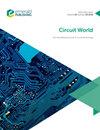A new two-element MIMO antenna system for cognitive radio applications
IF 0.7
4区 工程技术
Q4 ENGINEERING, ELECTRICAL & ELECTRONIC
引用次数: 2
Abstract
Purpose This study aims to propose a two-element multi-input-multi-output (MIMO) antenna for cognitive radio MIMO applications to avoid the complexities involved in reconfigurable antennas and improve the spectrum utilization efficiency. Design/methodology/approach The proposed MIMO antenna system comprises a wideband antenna that operates at 2 GHz–12 GHz for sensing the spectrum and four pairs of antennas for communication, which are single and dual-band antennas. Each pair of antennas meant for communication consists of two similar antennas. Moreover, the antennas meant for communication cover 93% of the bandwidth of the sensing antenna. Findings The first pair of antennas accessible at ports P2 and P6 and the second pair of antennas accessible at ports P4 and P8, which are dual-band antennas, operate at 3.05 GHz–3.85 GHz, 5.8 GHz–8 GHz and 2.05 GHz–2.55 GHz, 4.7 GHz–6.1 GHz, respectively. While the third pair of antennas accessible at ports P3 and P7 and the fourth pair of antennas accessible at ports P5 and P9 are single-band antennas and operate at 3.85 GHz–4.7 GHz and 8 GHz–11 GHz, respectively. Minimum isolations of 20 dB and 15 dB are attained between every two similar antennas for communication and between the sensing antenna and the antennas meant for communication, respectively. The correctness of the proposed antenna is verified with a fine match between the results obtained from simulations and measurements. Originality/value The proposed MIMO antenna possesses salient features, such as polarization diversity and performing a maximum of four communication tasks when all the white spaces are detected.一种用于认知无线电应用的新型双元MIMO天线系统
目的本研究旨在提出一种用于认知无线电MIMO应用的双元件多输入多输出(MIMO)天线,以避免可重构天线的复杂性,提高频谱利用效率。设计/方法/方法所提出的MIMO天线系统包括一个工作频率为2 GHz–12的宽带天线 用于感测频谱的GHz和用于通信的四对天线,它们是单波段和双频带天线。用于通信的每对天线由两个相似的天线组成。此外,用于通信的天线覆盖了传感天线带宽的93%。Findings可在端口P2和P6访问的第一对天线和可在端口P4和P8访问的第二对天线是双频天线,工作频率为3.05 GHz–3.85 GHz,5.8 GHz–8 GHz和2.05 GHz–2.55 GHz,4.7 GHz–6.1 GHz。而在端口P3和P7处可访问的第三对天线以及在端口P5和P9处可使用的第四对天线是单波段天线,工作频率为3.85 GHz–4.7 GHz和8 GHz–11 GHz。最小隔离20 dB和15 在用于通信的每两个类似天线之间以及在感测天线和用于通信的天线之间分别获得dB。仿真和测量结果之间的精确匹配验证了所提出天线的正确性。独创性/价值所提出的MIMO天线具有显著的特征,例如极化分集,并且在检测到所有空白时最多执行四个通信任务。
本文章由计算机程序翻译,如有差异,请以英文原文为准。
求助全文
约1分钟内获得全文
求助全文
来源期刊

Circuit World
工程技术-材料科学:综合
CiteScore
2.60
自引率
0.00%
发文量
33
审稿时长
>12 weeks
期刊介绍:
Circuit World is a platform for state of the art, technical papers and editorials in the areas of electronics circuit, component, assembly, and product design, manufacture, test, and use, including quality, reliability and safety. The journal comprises the multidisciplinary study of the various theories, methodologies, technologies, processes and applications relating to todays and future electronics. Circuit World provides a comprehensive and authoritative information source for research, application and current awareness purposes.
Circuit World covers a broad range of topics, including:
• Circuit theory, design methodology, analysis and simulation
• Digital, analog, microwave and optoelectronic integrated circuits
• Semiconductors, passives, connectors and sensors
• Electronic packaging of components, assemblies and products
• PCB design technologies and processes (controlled impedance, high-speed PCBs, laminates and lamination, laser processes and drilling, moulded interconnect devices, multilayer boards, optical PCBs, single- and double-sided boards, soldering and solderable finishes)
• Design for X (including manufacturability, quality, reliability, maintainability, sustainment, safety, reuse, disposal)
• Internet of Things (IoT).
 求助内容:
求助内容: 应助结果提醒方式:
应助结果提醒方式:


